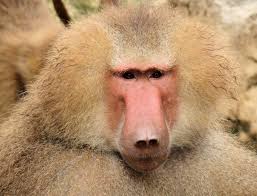
记忆方法
记忆“baboon”可以通过联想其外形特点。想象一只“ba”宝一样的动物,它的毛发又长又乱,像一团“bo”波涛汹涌的头发,这样的形象可以帮助记忆这个词,指的是狒狒这种动物。
以上内容由AI生成, 仅供参考和借鉴
中文词源
baboon 狒狒
可能来自拟声词,模仿狒狒发出的声音。
英语词源
- baboon
-
baboon: [14] The origins of baboon are obscure, but it seems that the notion underlying it may be that of ‘grimacing’. Baboons characteristically draw back their lips in snarling, revealing their teeth, and it has been speculated that there may be a connection with Old French baboue ‘grimace’. However that may be, it was certainly in Old French that the word first surfaced, as babuin, and originally it meant ‘gaping figure’ (as in a gargoyle) as well as ‘ape’. This alternative meaning was carried over when the Old French word was borrowed into English, where it remained a live sense of baboon until the 16th century.
- baboon (n.)
- type of old world ape, c. 1400, babewyn, earlier "a grotesque figure used in architecture or decoration" (early 14c.), from French babouin "baboon," from Old French baboin "ape," earlier "simpleton, dimwit, fool" (13c.), also "gaping figure (such as a gargoyle)," so perhaps from Old French baboue "grimacing;" or perhaps it is imitative of the ape's babbling speech-like cries. Also see -oon. German Pavian "baboon" is from Dutch baviaan, from Middle Dutch baubijn, a borrowing of the Old French word. Century Dictionary says Arabic maimun probably is from the European words.
权威例句
- 1. Baboon organs are too small to sustain people for long periods.
- 狒狒器官太小,无法支撑人类太长时间.
- 2. He moves like a baboon with two club feet.
- 他的动作,像一只有两条畸形腿的狒狒.
- 3. A baboon is a large monkey that lives in Africa.
- 狒狒是一种生活在非洲的大猴子.
- 4. If we had tails a baboon, where are they?
- 假如我有象狒狒那样的尾巴, 那么他们在哪儿 呢 ?
- 5. The quality and stability of baboon relationships trump quantity, the researchers say.
- 研究人员表示狒狒间社会关系的质量与稳定程度比数量更关键.